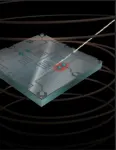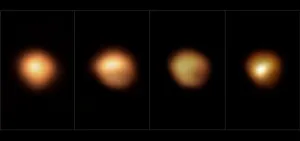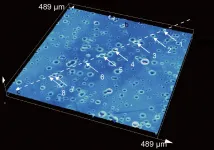Mystery solved: Dust cloud led to Betelgeuse's 'Great Dimming'
The star Betelgeuse became visibly darker in 2019 and 2020, puzzling astronomers; new images show that the star was partially concealed by a cloud of dust, solving the mystery of the 'Great Dimming' of Betelgeuse
2021-06-16
(Press-News.org) When Betelgeuse, a bright orange star in the constellation of Orion, lost more than two-thirds of its brightness in late 2019 and early 2020, astronomers were puzzled.
What could cause such an abrupt dimming?
Now, in a new paper published Wednesday in Nature, an international team of astronomers reveal two never-before-seen images of the mysterious darkening --and an explanation. The dimming was caused by a dusty veil shading the star, which resulted from a drop in temperature on Betelgeuse's stellar surface.
Led by Miguel Montargès at the Observatoire de Paris, the new images were taken in January and March of 2020 using the European Southern Observatory's Very Large Telescope. Combined with images previously taken in January and December 2019, the astronomers clearly capture how the stellar surface changed and darkened over time, especially in the southern region.
"For once, we were seeing the appearance of a star changing in real-time on a scale of weeks," Montargès says.
According to the astronomers, this abrupt dimming was caused by the formation of stardust.
Betelgeuse's surface regularly changes as giant bubbles of gas move, shrink and swell within the star. The team concludes that some time before the great dimming, the star ejected a large gas bubble that moved away from it, aided by the star's outward pulsation. When a patch of the surface cooled down shortly after, that temperature decrease was enough for the heavier elements (e.g. silicon) in the gas to condense into solid dust.
The new findings match Andrea Dupree's previous observations of Betelgeuse using the Hubble Space Telescope. Dupree, an astronomer at the Center for Astrophysics | Harvard & Smithsonian and a co-author on the new paper, captured signs of dense, heated material moving through the star's atmosphere in the months leading up to the great dimming.
"With Hubble, we could see the material as it left the star's surface and moved out through the atmosphere, before the dust formed that caused the star to appear to dim," Dupree says.
Dupree found that the material moved about 200,000 miles per hour as it traveled from the star's surface to its outer atmosphere. Once the gas bubble was millions of miles from the hot star, it cooled and formed a dust cloud that temporarily blocked the star's light.
The star returned to its normal brightness by April 2020.
Dupree, who has been studying Betelgeuse since 1985, hopes to continue studying the star in hopes of catching it eject another gas bubble.
"Betelgeuse is a unique star; it is enormous and nearby and we are observing material directly leaving the surface of the supergiant," she says. "How and where material is ejected affects our understanding of the evolution of all stars!"
INFORMATION:
About the Center for Astrophysics | Harvard & Smithsonian
The Center for Astrophysics | Harvard & Smithsonian is a collaboration between Harvard and the Smithsonian designed to ask--and ultimately answer--humanity's greatest unresolved questions about the nature of the universe. The Center for Astrophysics is headquartered in Cambridge, MA, with research facilities across the U.S. and around the world.
ELSE PRESS RELEASES FROM THIS DATE:
2021-06-16
EMBARGOED UNTIL 11 A.M. ET WEDNESDAY, JUNE 16, 2021
MADISON, Wis. -- Quantum computers could outperform classical computers at many tasks, but only if the errors that are an inevitable part of computational tasks are isolated rather than widespread events. Now, researchers at the University of Wisconsin-Madison have found evidence that errors are correlated across an entire superconducting quantum computing chip -- highlighting a problem that must be acknowledged and addressed in the quest for fault-tolerant quantum computers.
The researchers report their findings in a study published June 16 in the journal Nature, Importantly, their work also points to mitigation strategies.
"I think people have been approaching the problem of error correction in an overly optimistic ...
2021-06-16
It is possible to re-create a bird's song by reading only its brain activity, shows a first proof-of-concept study from the University of California San Diego. The researchers were able to reproduce the songbird's complex vocalizations down to the pitch, volume and timbre of the original.
Published June 16 in Current Biology, the study lays the foundation for building vocal prostheses for individuals who have lost the ability to speak.
"The current state of the art in communication prosthetics is implantable devices that allow you to generate textual output, writing up to 20 words per minute," said senior author Timothy Gentner, a professor of psychology and neurobiology ...
2021-06-16
When Betelgeuse, a bright orange star in the constellation of Orion, became visibly darker in late 2019 and early 2020, the astronomy community was puzzled. A team of astronomers have now published new images of the star's surface, taken using the European Southern Observatory's Very Large Telescope (ESO's VLT), that clearly show how its brightness changed. The new research reveals that the star was partially concealed by a cloud of dust, a discovery that solves the mystery of the "Great Dimming" of Betelgeuse.
Betelgeuse's dip in brightness -- a change noticeable even to the ...
2021-06-16
What The Study Did: Researchers examined to what extent cannabis use is associated with thickness in brain areas measured by magnetic resonance imaging in a study of adolescents.
Authors: Matthew D. Albaugh, Ph.D., of the University of Vermont Larner College of Medicine in Burlington, is the corresponding author.
To access the embargoed study: Visit our For The Media website at this link https://media.jamanetwork.com/
(10.1001/jamapsychiatry.2021.1258)
Editor's Note: The article includes conflict of interest and funding/support disclosures. Please see the article for additional information, including other authors, author contributions and affiliations, conflict of interest and financial disclosures, and funding and support.
INFORMATION:
Media advisory: The ...
2021-06-16
What The Study Did: Survival among people with early-onset (diagnosed before age 50) colorectal cancer compared with later-onset colorectal cancer (diagnosed at ages 51 through 55) was compared using data from the National Cancer Database.
Authors: Charles S. Fuchs, M.D., M.P.H., of the Yale School of Public Health in New Haven, Connecticut, is the corresponding author.
To access the embargoed study: Visit our For The Media website at this link https://media.jamanetwork.com/
(doi:10.1001/jamanetworkopen.2021.12539)
Editor's Note: The article includes conflicts of interest and funding/support disclosures. Please see the article for additional information, including other authors, author contributions and affiliations, conflict of interest and financial disclosures, and funding and ...
2021-06-16
What The Study Did: This study demonstrated an association between receiving the mRNA-1273 (Moderna) vaccine and a reduction in SARS-CoV-2 infection in health care workers beginning eight days after the first dose.
Authors: Michael E. Charness, M.D., of the VA Boston Healthcare System in West Roxbury, Massachusetts, is the corresponding author.
To access the embargoed study: Visit our For The Media website at this link https://media.jamanetwork.com/
(doi:10.1001/jamanetworkopen.2021.16416)
Editor's Note: The article includes conflict of interest ...
2021-06-16
A ball of 4,000-year-old hair frozen in time tangled around a whalebone comb led to the first ever reconstruction of an ancient human genome just over a decade ago.
The hair, which was preserved in arctic permafrost in Greenland, was collected in the 1980s and stored at a museum in Denmark. It wasn't until 2010 that evolutionary biologist Professor Eske Willerslev was able to use pioneering shotgun DNA sequencing to reconstruct the genetic history of the hair.
He found it came from a man from the earliest known people to settle in Greenland ...
2021-06-16
Stimulation of the nervous system with neurotechnology has opened up new avenues for treating human disorders, such as prosthetic arms and legs that restore the sense of touch in amputees, prosthetic fingertips that provide detailed sensory feedback with varying touch resolution, and intraneural stimulation to help the blind by giving sensations of sight.
Scientists in a European collaboration have shown that optic nerve stimulation is a promising neurotechnology to help the blind, with the constraint that current technology has the capacity of providing only simple visual signals.
Nevertheless, the scientists' vision (no pun intended) is to design these simple visual signals to be meaningful in assisting the blind with daily living. Optic nerve stimulation ...
2021-06-16
Although plexiglass barriers are seemingly everywhere these days -- between grocery store lanes, around restaurant tables and towering above office cubicles -- they are an imperfect solution to blocking virus transmission.
Instead of capturing virus-laden respiratory droplets and aerosols, plexiglass dividers merely deflect droplets, causing them to bounce away but remain in the air. To enhance the function of these protective barriers, Northwestern University researchers have developed a new transparent material that can capture droplets and aerosols, effectively ...
2021-06-16
New York, NY (June 16, 2021) -- Immune cells that normally repair tissues in the body can be fooled by tumors when cancer starts forming in the lungs and instead help the tumor become invasive, according to a surprising discovery reported by Mount Sinai scientists in Nature in June.
The researchers found that early-stage lung cancer tumors coopt the immune cells, known as tissue-resident macrophages, to help invade lung tissue. They also mapped out the process, or program, of how the macrophages allows a tumor to hurt the tissues the macrophage normally repairs. This process allows the tumor to hide from the immune system and proliferate into later, deadly stages of cancer.
Macrophages play a key ...
LAST 30 PRESS RELEASES:
[Press-News.org] Mystery solved: Dust cloud led to Betelgeuse's 'Great Dimming'
The star Betelgeuse became visibly darker in 2019 and 2020, puzzling astronomers; new images show that the star was partially concealed by a cloud of dust, solving the mystery of the 'Great Dimming' of Betelgeuse


